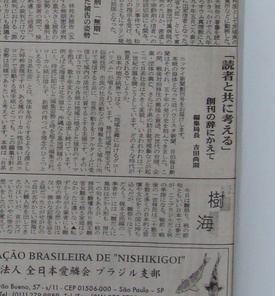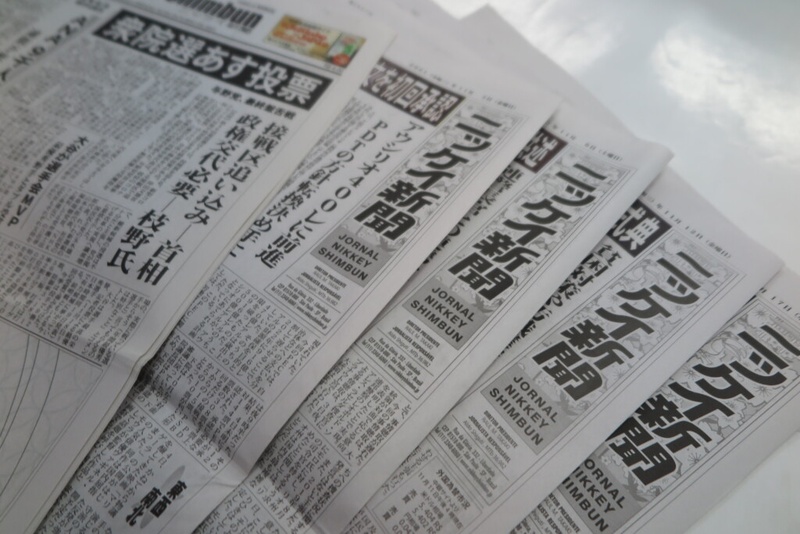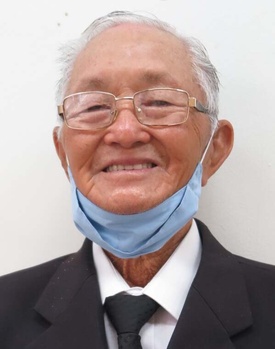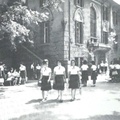On page 2 of the November 18, 2021 issue of the Nikkei Shimbun, President Raul Takagi announced that the newspaper would cease publication with the December 18 issue. It is unfortunate, but the newspaper (Nikkei Shimbun) will close in just one month.
When we asked Kazusuke Shiraishi, former president of the Noroeste United Japan-Brazil Cultural Association, for his comment on this, he reaffirmed the value of Japanese-language newspapers, saying, "We would be really in trouble if newspapers disappeared. If we don't read them every day, we won't know about Japanese organizations and we'll forget Japanese."
Shiraishi is a second-generation Japanese who was born on June 11, 1935 in Gararapes, Sao Paulo State.
He continued, "My father also read Japanese newspapers. When I finished volume 12 at Japanese language school, there were no textbooks that could teach me any further. When I told my father about it, he said, 'You should read the newspaper too. At first there will be some parts you don't understand, so skip those and just read it every day. If you do that, you will gradually begin to understand.'"
Shiraishi followed his father's advice and learned to read newspapers. Since then, he has read Japanese newspapers without fail.
President Raul has worked exclusively for Japanese newspapers for 40 years.
President Raul reiterated, "I have been able to work for a Japanese-language newspaper for 40 years thanks to our loyal readers. I would like to express my sincere gratitude for having been able to continue this far."
President Raul is 75 years old and was born in São Paulo in January 1946. After graduating from the law department of Catholic University, he worked at Nishi Isao Law Office, where he became acquainted with Toshihiko Nakabayashi, president of the Nippaku Mainichi Shimbun (hereafter, Nippaku Mainichi Shimbun), which was located in the same building. Attorney Nishi also served as Nippaku's legal director.
Through this connection, he joined Hikami in 1981 and has worked for Japanese language newspapers for 40 years. He then said, "I quietly took over as president in 1983."
The reason why he said it was "secretly" was that he was still a young man of 37 at the time, and President Raul was worried that people around him would not trust him if he suddenly became the president of a Japanese-language newspaper.
He apparently asked Nakabayashi to "keep it a secret for a while and wait for it to become known naturally," before taking over.
President Raul recalled, "When I accepted President Nakabayashi's request, I first consulted with Mr. Ichimono. He said, 'If it's Raul, I'll continue too,' so I made the decision." Mr. Ichimono was the editor-in-chief at the time.
Initially, President Nakabayashi selected Takashi Wakamatsu, a postwar immigrant who had founded the highly successful Sol Nascente Securities, as his successor. Wakamatsu was a former Paulista newspaper reporter, had extensive knowledge of Japanese language newspapers, and possessed ample financial resources, making him the ideal candidate.
However, Wakamatsu sent one of his own employees to the newspaper company for a week to investigate its financial situation, and they responded that they could not take on the job.
The company was already facing labor lawsuits and other issues, and its business was in a bad state. As a result, the company chose Raul, a second-generation Japanese who was familiar with local conditions and a law graduate lawyer with experience in court cases.
With a second-generation Japanese-born Japanese man taking over as president, Nihonmai began to focus on diversifying into magazine publishing and expanding its Portuguese-language pages, among the three Japanese-language newspapers available at the time.
The lithographic printing press goes, go, go.
President Raul recalls, "When I became president, the printing presses were flatbed and would print each page, one by one, with a clang, clang. So just printing took six hours. Paulista Newspaper and São Paulo Newspaper have already introduced the latest rotary presses, and it now takes less than an hour. I've helped with everything from printing to folding in the shipping department and delivery."
The biggest challenge facing management at the time was hyperinflation. "Inflation was so bad that we often couldn't pay salaries. So we managed to distribute food vouchers every Friday," he recalled.
He continued, "One of the employees who had worked for him for many years passed away, and when I went to the funeral, I was introduced to his family. I was really surprised to see that all of his children had respectable professions, with the third son being a lawyer, the other a doctor, and so on. I was amazed and wondered how he was able to give his children such an education on that salary."
Paulista Shimbun and Nichi-Mai merged in 1998, with a history of 23 years.

Looking back, the Nikkei Shimbun was launched on March 3, 1998, through the merger of two Japanese language newspapers, the Paulista Shimbun (founded in January 1947) and the Nipaku Mainichi Shimbun (founded in January 1949), both of which boasted half a century of history.
It started without any ceremony, with a sudden change in the newspaper, and has since become a 23-year-old tradition.
In the inaugural issue, Editor-in-Chief Yoshida Takanori argued as follows in "In lieu of an inaugural statement: 'Thinking together with our readers'":
Japan's local newspapers have their own unique themes rooted in the region, which they have pursued unchanged for decades. Following this example, the Nikkei Shimbun has set forth "an editorial stance that responds to the trends of the times and an editorial policy that transcends time" as its guiding principle.
He goes on to argue that now that subsequent immigrants have stopped, we are in an era where the baton cannot be passed on from one Issei to the next, and that "the baton, which carries the warmth of the Issei, must be handed over directly to their descendants."
In Brazil, an experimental nation where the mixing of races and cultures is progressing, the newspaper declared, "As a source of information on 'globalism in regionalism,' we convey the process and results of this experiment to communities in Japan and other countries where immigrants came from, and report the information we have learned from those regions to the Japanese community. That is the kind of newspaper we hope to be."
As to what extent those lofty ambitions have been realized... to be honest, I'm not very confident.
However, at least during that time, we have recorded articles about important milestones, such as the 100th anniversary of immigration (2008), when the Crown Prince (now the Emperor) visited Brazil, the 120th anniversary of the establishment of diplomatic relations (2015), and the 110th anniversary when Princess Mako was welcomed (2018).
In particular, it has focused on the Colonia Publications department, producing numerous publications in both Japanese and Portuguese.
In April 2009, a 100th anniversary photo book, " Portraits from the 100th Year: 2008 as Followed by Japanese Newspapers " (Japanese and Portuguese, full color) was published.
Thanks to the efforts of Horie Takeshi, who was a reporter for this newspaper at the time (he lives in Hiroshima and is currently a director of the Hiroshima Japan-Brazil Association), the publication of “ Amazon: 80 Years of Japanese Immigration ,” a collection of serialized articles commemorating the 80th anniversary of the settlement of the Amazon in 2009, became the starting point for the subsequent publishing project.
In January 2016, he began publishing a bilingual series of books titled " Cultura Japonesa" (Japanese Culture) , in collaboration with the São Paulo Youth Library.
The magazine continues to publish two or three issues a year, and in March 2019 it released the ninth issue of "Japanese Culture, " a special photo collection of Princess Mako's visit to Brazil, which was well received.
In addition, Paulista Shimbun started a journalist training program in 1990. Nihonbashi has been accepting students from the Japan-Brazil Exchange Association every year since the 1980s, and if both streams are added together, well over 70 people have been trained through the journalist training program.
Many of these trainees aspire to work in the media, and many of them have gone on to work for newspapers and television stations after returning home, including the Asahi Shimbun, Yomiuri Shimbun, NHK, Chunichi Shimbun, Hokkaido Shimbun, Kochi Shimbun, Gifu Shimbun, and Kobe Shimbun.
There are many journalists who are familiar with the Japanese Brazilian community and are active in Japan. Nurturing such human resources is also an important role of Japanese language newspapers. Raul Takagi, president of our newspaper, has always emphasized the role of newspapers in "nurturing Japan's youth."
© 2021 Masayuki Fukasawa / Nikkey Shinbun








